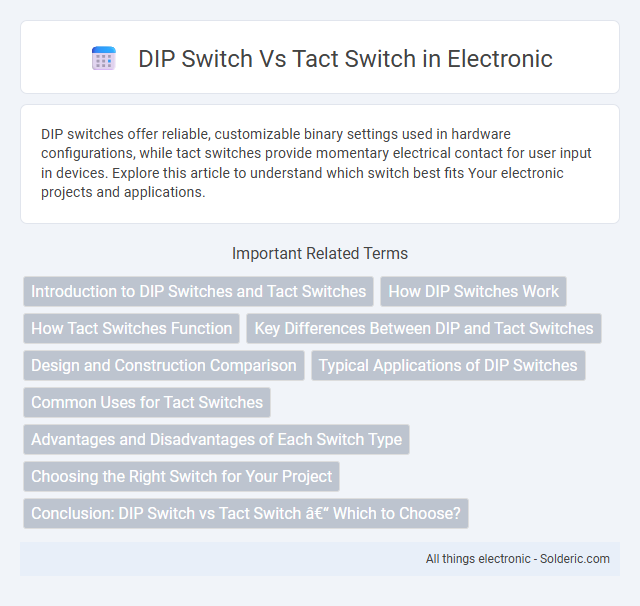DIP switches offer reliable, customizable binary settings used in hardware configurations, while tact switches provide momentary electrical contact for user input in devices. Explore this article to understand which switch best fits Your electronic projects and applications.
Comparison Table
| Feature | DIP Switch | Tact Switch |
|---|---|---|
| Definition | Manual electronic switch with multiple switches in a single package. | Momentary push-button switch for temporary electrical connection. |
| Use Case | Settings configuration, binary input selection. | User input, control buttons, reset switches. |
| Operation | Toggle switch ON/OFF, stable until changed. | Press to activate, returns to default OFF state. |
| Size | Generally larger, multiple poles. | Small, compact, single contact. |
| Mounting Type | Through-hole or surface mount. | Surface mount mostly. |
| Durability | High mechanical life, reliable for settings. | Moderate life span, designed for frequent press. |
| Cost | Low to moderate. | Low cost. |
Introduction to DIP Switches and Tact Switches
DIP switches are compact, manually operated electrical switches used to configure settings on circuit boards, featuring multiple small toggle switches in a dual in-line package. Tact switches, also known as tactile switches, are momentary push-button switches that provide tactile feedback when pressed, commonly used for user input in devices like remote controls and keyboards. Your choice between DIP switches and tact switches depends on whether you need configurable hardware settings or simple user-activated signals.
How DIP Switches Work
DIP switches operate by toggling small internal metal contacts to create an open or closed circuit, allowing precise control over electronic device settings. Each switch position corresponds to a binary value, enabling customized configurations directly on a circuit board without software intervention. Understanding how DIP switches work can help you select the right configuration method for your project, especially when requiring simple, reliable manual control.
How Tact Switches Function
Tact switches function as momentary contact switches that complete an electrical circuit only while being pressed, typically used for user input in compact electronic devices. They operate through a small, spring-loaded plunger that closes the circuit when pressed, providing tactile feedback for precise control. Your device relies on the quick and reliable response of tact switches compared to DIP switches, which are used primarily for setting configurations rather than momentary inputs.
Key Differences Between DIP and Tact Switches
DIP switches feature multiple small switches in a single package, allowing for binary on/off settings ideal for configuring electronic devices, while tact switches are single, momentary push-buttons used for user input. DIP switches provide a stable, discrete configuration setting unaffected by accidental presses, whereas tact switches are designed for tactile feedback and short-term activation. The key difference lies in DIP switches' role in hardware settings versus tact switches' use in user interface controls.
Design and Construction Comparison
DIP switches feature a row of small sliding or toggle switches mounted on a dual in-line package, allowing for straightforward integration into printed circuit boards with a compact, modular design. Tact switches consist of a small, push-button mechanism with a dome-shaped metal contact that provides tactile feedback, designed for momentary user input in compact electronic devices. The rigid and segmented construction of DIP switches contrasts with the flexible, responsive design of tact switches, making each suited for different functional applications in electronic circuits.
Typical Applications of DIP Switches
DIP switches are commonly used in setting hardware configurations on circuit boards, such as selecting device modes or enabling features in consumer electronics and industrial control systems. They serve as reliable manual input devices in applications like communication devices, instrumentation, and computer peripherals for simple on/off settings. Their compact size and ease of use make them ideal for configuring embedded systems and small-scale hardware adjustments.
Common Uses for Tact Switches
Tact switches are commonly used in consumer electronics, such as remote controls, mobile devices, and gaming controllers, where precise, momentary input is required. These switches provide tactile feedback and are ideal for applications needing small, low-profile components that register a single press. Your devices benefit from tact switches' reliability and compact design, making them essential for user interfaces demanding quick and accurate responses.
Advantages and Disadvantages of Each Switch Type
DIP switches offer reliable position stability and ease of setting multiple configurations simultaneously, with advantages including compact size and low power consumption, but they lack tactile feedback and can be difficult to operate in tight spaces. Tact switches provide a responsive tactile feedback ideal for user interfaces and momentary activation, with benefits such as ease of use and high durability, but they are generally limited to single-pole, single-throw operations and can wear out faster under heavy use. Choosing between DIP and tact switches depends on application requirements like configuration complexity, user interaction, and environmental factors.
Choosing the Right Switch for Your Project
Selecting the right switch depends on your project's functionality and space requirements, with DIP switches ideal for multi-position configuration settings and Tact switches suited for momentary, tactile feedback applications. DIP switches offer reliable binary input selections for circuit boards, while Tact switches provide compact, user-friendly actuation for control panels or handheld devices. Evaluating durability, size, and switching type ensures optimal integration and performance in your electronic design.
Conclusion: DIP Switch vs Tact Switch – Which to Choose?
DIP switches offer reliable, manual configuration for devices requiring multiple on/off settings, making them ideal for circuit customization and hardware debugging. Tact switches provide momentary contact for user input, perfect for reset buttons or user controls needing short, precise activation. Choose a DIP switch for stable, long-term setting adjustments and a tact switch for quick, responsive user interactions.
DIP Switch vs Tact Switch Infographic

 solderic.com
solderic.com